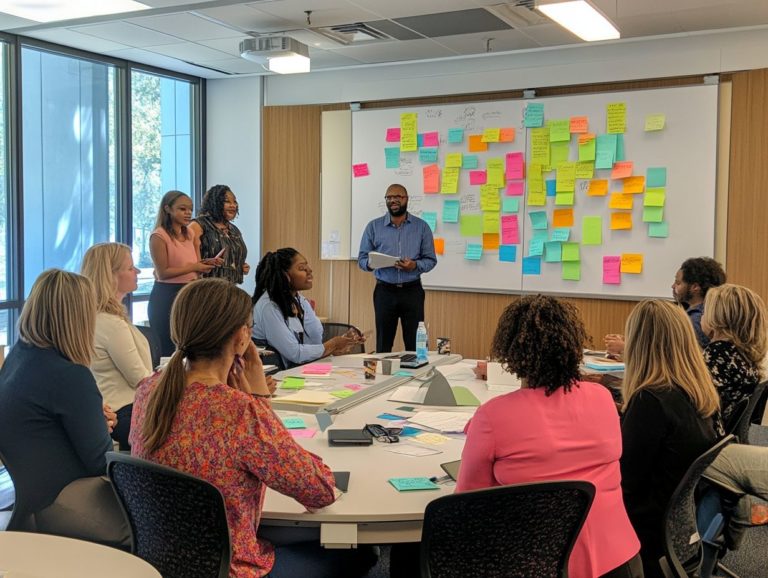The Role of Feedback in Leadership Growth
In the ever-evolving realm of leadership, feedback is not merely beneficial; it is vital for both personal and professional growth. It influences how you engage with your teams and nurtures their development.
This article delves into the profound significance of feedback, drawing clear distinctions between constructive and destructive forms. It also provides you with effective strategies for both giving and receiving feedback.
Through real-life examples and insights on fostering a culture rich in feedback, get ready to transform your leadership effectiveness and boost your team’s performance to new heights.
Contents
- Key Takeaways:
- The Importance of Feedback in Leadership
- Types of Feedback in Leadership
- Mastering the Art of Feedback as a Leader
- Receiving Feedback as a Leader
- The Impact of Feedback on Leadership Growth
- Creating a Culture of Feedback in Leadership
- Frequently Asked Questions
- What is the role of feedback in leadership growth?
- How does feedback contribute to leadership development?
- Why is it important for leaders to seek feedback?
- Can feedback be used as a tool for personal growth for leaders?
- How can leaders use feedback to create a positive work environment?
- What are some best practices for giving and receiving feedback in leadership?
Key Takeaways:

- Feedback is crucial for leadership growth as it provides a clear understanding of strengths and areas for improvement.
- Effective feedback involves being constructive, formal, and utilizing best practices and techniques.
- The implementation of a feedback culture in leadership can lead to a more dynamic and successful workplace.
The Importance of Feedback in Leadership
Feedback is an essential pillar in nurturing your leadership development and enhancing employee engagement.
It acts as a vital link for open communication between you and your team members, fostering a culture where constructive criticism flourishes.
By implementing effective performance reviews and coaching, you can elevate employee performance and cultivate a feedback culture that promotes continuous improvement.
As a successful leader, you recognize that integrating feedback mechanisms is crucial to fostering transformational leadership, which means inspiring and motivating your team to achieve their best.
Why Feedback is Essential for Growth
Feedback is crucial for your growth; it opens the door to self-reflection, sharpening your leadership skills and enhancing overall employee performance. When you actively seek and welcome feedback, you cultivate an environment ripe for continuous improvement.
Consider a manager who consistently asks for input from their team. This approach reveals blind spots and nurtures a culture of openness. It s not just about personal accountability; it encourages everyone to take a closer look at their own practices too.
By thoughtfully evaluating the feedback you receive, you can pinpoint specific areas for development, like refining your communication or decision-making skills. This process allows you to transform potential weaknesses into formidable strengths.
As you gradually evolve in these areas, not only will your individual performance soar, but you’ll also empower your team members, instilling in them a sense of confidence and motivation that drives collective success.
Types of Feedback in Leadership
Understanding the various types of feedback is essential for effective leadership, especially when it comes to distinguishing between constructive and destructive feedback. Each type carries the potential to significantly influence team dynamics and employee performance.
Recognizing this nuance allows you to foster a more productive and harmonious work environment.
Constructive vs. Destructive Feedback
Constructive feedback plays a vital role in cultivating a positive environment, enhancing performance optimization and boosting employee morale, while destructive feedback can stifle growth and disrupt team dynamics.
When you deliver constructive feedback thoughtfully, it can significantly build confidence, enhance skills, and empower individuals to take charge of their development. On the flip side, destructive feedback tends to evoke feelings of inadequacy and resentment, creating obstacles to effective communication and collaboration within the team.
To mitigate the adverse effects of destructive feedback, it s crucial to implement strategies that ensure feedback is provided in a supportive context. This could involve establishing regular feedback loops that encompass not just evaluations but also ample opportunities for employees to voice their concerns and suggestions.
By promoting an environment where feedback flows both ways, you can foster a culture of continuous improvement and resilience within your organization.
Formal vs. Informal Feedback

The distinction between formal and informal feedback is crucial for you as a leader aiming to optimize how you deliver feedback and establish effective feedback mechanisms.
Understanding these two forms can significantly enhance your coaching strategies and elevate overall team performance. For instance, formal feedback typically occurs during scheduled performance reviews. It s structured to evaluate an employee s accomplishments against predefined objectives. Informal feedback, on the other hand, can emerge spontaneously during everyday interactions, allowing you to address concerns or acknowledge achievements in real-time.
Think of formal feedback as a structured evaluation incorporating specific performance metrics. Informal feedback might take the form of a casual conversation after a successful project wrap-up. By integrating both approaches, you ll foster a comprehensive feedback culture that encourages continuous improvement across your team.
Mastering the Art of Feedback as a Leader
Providing effective feedback is an essential skill that requires you to utilize a range of feedback strategies. Make your feedback clear and actionable to truly connect with your team!
Best Practices and Techniques
Implementing best practices and techniques for feedback delivery ensures that you not only receive feedback but also feel motivated to enhance your performance.
To achieve this, employ various strategies to craft feedback that is both constructive and encouraging. Start with positive reinforcement, celebrating what you have done well before diving into areas needing improvement. This approach also fosters trust and sets the stage for open dialogue.
Proactive feedback involves setting clear expectations and providing guidance throughout a project. This allows you to adjust your efforts as needed. When organizations emphasize receiving feedback, they create a culture of continuous improvement, where you feel valued and have the power to refine your skills, ultimately driving success for everyone involved.
Receiving Feedback as a Leader
Receiving feedback is as vital as giving it; it boosts your effectiveness and fosters self-reflection.
Embrace this exchange now! It can skyrocket your leadership journey to new heights.
How to Handle and Utilize Feedback Effectively
Handling and utilizing feedback effectively requires embracing constructive criticism and weaving it into your leadership development journey. This approach promotes your personal growth and creates a space for open talks and collaboration within your team.
By actively seeking input from both peers and subordinates, you can elevate your effectiveness as a leader, fostering a culture where feedback is not just welcomed but regularly exchanged. Implementing feedback loops structured ways to gather and act on feedback can help refine your skills.
By adopting a mindset of continuous improvement, you can transform criticism into actionable insights, strengthening relationships and boosting overall team performance.
The Impact of Feedback on Leadership Growth

The impact of feedback on your leadership growth is profound. It shapes not just your development but also cultivates a robust performance feedback culture within your organization.
Start applying these feedback strategies today to see immediate improvements!
Real-life Examples and Case Studies
Real-life examples and case studies vividly illustrate the transformational leadership that thrives within a robust feedback culture, showing how feedback optimizes performance.
Consider a technology firm that embraced a 360-degree feedback system. This method invites everyone to share insights about their peers and leaders. The result? Enhanced communication and a strong feeling of teamwork and accountability among team members.
Another example is a healthcare organization that instituted regular feedback sessions to address staff concerns. This initiative led to improved patient care and boosted employee morale.
These examples demonstrate that effective feedback mechanisms can fuel leadership growth while fostering a collaborative organizational culture that values adaptability and continuous improvement.
Creating a Culture of Feedback in Leadership
Establishing a culture of feedback in leadership is vital for creating an environment where workplace feedback is genuinely valued and seamlessly integrated into daily operations. This approach enhances engagement strategies and promotes a receptive atmosphere among employees, encouraging them to embrace feedback with enthusiasm.
Encouraging and Utilizing Feedback in the Workplace
Encouraging and embracing feedback in the workplace is essential for enhancing team dynamics and elevating employee morale. When you create an environment where team members feel comfortable sharing their thoughts and suggestions, it paves the way for open dialogue that can spark innovative solutions and foster improved collaboration.
Implementing structured feedback mechanisms such as regular check-ins or anonymous surveys can greatly facilitate this valuable exchange. Recognizing and acting on the feedback you receive shows that you value contributions and cultivates a culture of trust and respect.
Creating a feedback-rich environment can lead to amazing results! You typically see heightened engagement, elevated productivity levels, and a tangible sense of camaraderie among team members. Ultimately, this leads to a more fulfilling workplace experience for everyone involved.
Frequently Asked Questions
What is the role of feedback in leadership growth?

The role of feedback in leadership growth is crucial, as it helps leaders identify their strengths and weaknesses. Understanding the role of feedback in skill enhancement allows them to make necessary improvements to become more effective.
How does feedback contribute to leadership development?
Feedback provides leaders with valuable insights and perspectives from their team members, allowing them to gain a better understanding of their impact and make necessary changes to improve their leadership skills.
Why is it important for leaders to seek feedback?
Seeking feedback shows that leaders are open to learning and continuously improving themselves. It also creates a culture of open communication and trust within the team.
Can feedback be used as a tool for personal growth for leaders?
Yes, feedback can be a powerful tool for personal growth. It provides leaders with valuable information about their leadership style and behaviors, allowing them to reflect and make positive changes.
How can leaders use feedback to create a positive work environment?
By actively seeking feedback and using it to make improvements, leaders can foster a culture of open communication and continuous growth within their team. This can lead to a more positive and productive work environment.
What are some best practices for giving and receiving feedback in leadership?
When giving feedback, it’s important to be specific, timely, and focus on behaviors rather than personal traits. When receiving feedback, leaders should listen actively, show appreciation, and view it as an opportunity for growth rather than becoming defensive.
Ready to implement feedback in your leadership style? Start today!






